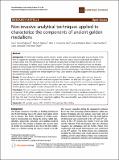Por favor, use este identificador para citar o enlazar a este item:
http://hdl.handle.net/10261/73544COMPARTIR / EXPORTAR:
 SHARE
BASE SHARE
BASE
|
|
| Visualizar otros formatos: MARC | Dublin Core | RDF | ORE | MODS | METS | DIDL | DATACITE | |

| Título: | Non-Invasive Analytical Techniques Applied to Characterize the Components of Ancient Golden Medallions |
Autor: | Pérez-Rodríguez, José Luis CSIC; Robador, M. D.; Jiménez de Haro, María del Carmen CSIC ORCID; Martínez-Blanes, José M. CSIC ORCID; Garofano, Isabel; Odriozola, Carlos; Durán, Adrián CSIC ORCID | Fecha de publicación: | 3-abr-2013 | Editor: | Chemistry Central | Citación: | Heritage Science 1(1) : 4- (2013) | Resumen: | Abstract Background The first stable material used to create a gilded surface was gold. False gold was also found in the form of copper-zinc powders or silver covered with resin. There are various ways to make gold leaf adhere to a large surface area. The identification of the materials and processes to make the gilding and the use of non- invasive techniques for gilding study is still an open problem. The gilding of the medallions from the Mudejar palace of Sevilla Alcazar was investigated, and their components were characterised using non-invasive (in situ and laboratory) techniques such as X-ray fluorescence, μ-Raman, infrared spectroscopy, X-ray diffraction and scanning electron microscopy coupled with energy dispersive X-rays. Cross-sections of golden support were also performed and studied by SEM-EDX. Results The leaf adhered to the surface was primarily a gold alloy. However, copper, silver and zinc were also found. A layer of lead chromate with some lead sulphate was between the alloy and the support. This yellow pigment (lead chromate) and the layers of bole and white lead were characterised in cross-sections prepared from samples taken from the medallions in which the golden layer was missing. The support was composed of gypsum. Another golden layer applied in oldest time period was also found. Conclusion The non-invasive techniques provided useful information about the characterisation of the components of the golden medallions. However, complete characterisation of the medallions required the use of other techniques such as mass spectrometry and scanning electron microscopy- energy dispersive X-ray. This is the first time that lead chromate has been detected in gildings. The external gilding was applied at the beginning of the 19th century using mordant oil (linseed oil). | URI: | http://hdl.handle.net/10261/73544 | Identificadores: | http://dx.doi.org/10.1186/2050-7445-1-4 |
| Aparece en las colecciones: | (ICMS) Artículos |
Ficheros en este ítem:
| Fichero | Descripción | Tamaño | Formato | |
|---|---|---|---|---|
| 2050-7445-1-4.xml | 69,78 kB | XML | Visualizar/Abrir | |
| 2050-7445-1-4.pdf | 2,51 MB | Adobe PDF |  Visualizar/Abrir |
CORE Recommender
Page view(s)
306
checked on 19-abr-2024
Download(s)
473
checked on 19-abr-2024
Google ScholarTM
Check
NOTA: Los ítems de Digital.CSIC están protegidos por copyright, con todos los derechos reservados, a menos que se indique lo contrario.
